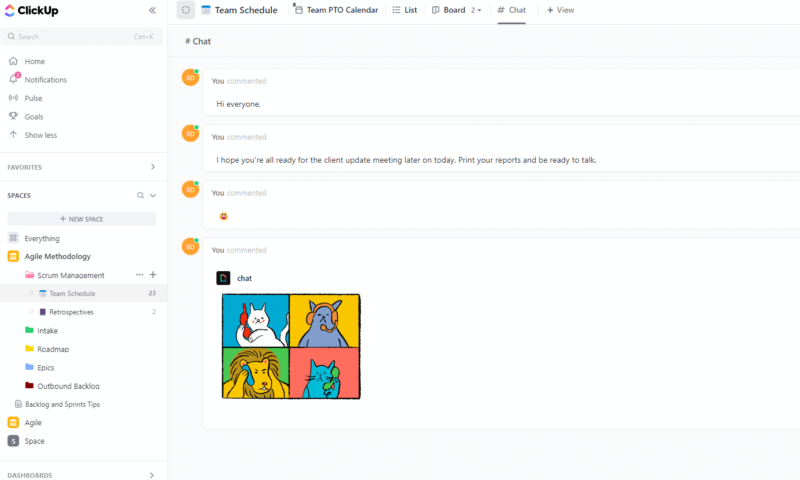The best project management software platforms have tools that allow you to run and complete sprints efficiently. However, despite their benefits, these tools don’t guarantee successful sprint execution; that’s up to you and your team. If you want to successfully execute your next sprint, read this guide to learn how to reach your sprint goal effectively.
This article will define sprint execution, outline who oversees scrum teams and teach you how to assess the success of your sprint execution. We’ll also cover sprint duration so you can learn how long it should take to execute a sprint.
Definition, Meaning & Summary: What Is a Sprint Execution?
Sprint execution is the process of working on a series of tasks and ensuring they’re completed within a specific time frame. Successful sprint execution is also measured by the quality of the finished result. For example, if a development team builds a new feature that works as intended, you can view this as a successful sprint execution.
Who Participates in a Sprint Execution?
Traditionally, a scrum team is responsible for sprint execution. The team comprises a product owner, a scrum master and a development team. Scrum developers are responsible for working on relevant tasks that make up the sprint backlog.
Who Manages the Team’s Work During a Sprint?
The scrum master oversees the scrum team’s work during a sprint. They’re heavily involved in sprint planning, and they work alongside the product owner. The scrum master also facilitates daily meetings to discuss sprint progress and ensure that the scrum team isn’t overcommitting, helping to prevent scope creep.
Sprint Execution Process: How It Works
To give you a clear understanding of the sprint execution process, we’ll take you through each step, from initial planning to task completion.

When Is Sprint Execution Completed?
Sprint execution begins after the initial sprint planning and ends before the sprint review. In practical terms, it should finish when the scrum team completes the product backlog. However, sometimes the product backlog will be too large for the team to complete all tasks within the sprint time frame.
Such issues should be brought up either in the daily scrum meetings or in the sprint review. The review shows stakeholders and clients the latest iteration of a product, allowing them to provide feedback. For more details on how to conduct a review, check out our guide that explains what a sprint review is.
At the end of a sprint, the team will also conduct a sprint retrospective to discuss how the previous sprint went. During this event, the scrum team will celebrate wins, discuss losses and brainstorm how to improve the next sprint.
Final Thoughts
The foundation of strong sprint execution is planning and communication. If you get those two right, then it’s much easier for all the other processes to fall into place. Also, using the sprint review to receive feedback from clients and stakeholders can help teams refine the sprint backlog and prepare for the next sprint.
Using modern project management software is also the best way to lock down your processes, as they’re built to make your professional life easier. If you’re looking for new software, be sure to read our monday.com review and our ClickUp review. These platforms are both market leaders that offer plenty of tools to help you improve your sprint execution.
Did you find this guide useful? What helps you improve sprint execution? What else would you like to learn about project management? Let us know in the comments. Thanks for reading.
FAQ: Sprint Execution Definition, Steps & Activities
-
In Agile, sprint execution refers to how a development team will complete specific tasks related to a piece of software. This often relates to building specific features and sections of a software product.
-
The four core steps of a sprint are planning, execution, review and retrospective. They allow you to build a strategy, complete the work effectively, discuss how the work went, demo the latest product iteration and identify improvements for future sprints.
-
Scrum sprint planning begins once the product owner has relayed the project objectives. The scrum master can then create a product backlog and assign specific tasks to appropriate team members so they can execute them correctly.
{“@context”:”https:\/\/schema.org”,”@type”:”FAQPage”,”mainEntity”:[{“@type”:”Question”,”name”:”What Is Sprint Execution in Agile?”,”acceptedAnswer”:{“@type”:”Answer”,”text”:”
In Agile, sprint execution refers to how a development team will complete specific tasks related to a piece of software. This often relates to building specific features and sections of a software product.\n”}},{“@type”:”Question”,”name”:”What Are the 4 Steps Within a Sprint?”,”acceptedAnswer”:{“@type”:”Answer”,”text”:”
The four core steps of a sprint are planning, execution, review and retrospective. They allow you to build a strategy, complete the work effectively, discuss how the work went, demo the latest product iteration and identify improvements for future sprints.\n”}},{“@type”:”Question”,”name”:”How to Plan and Execute Scrum Sprints?”,”acceptedAnswer”:{“@type”:”Answer”,”text”:”
Scrum sprint planning begins once the product owner has relayed the project objectives. The scrum master can then create a product backlog and assign specific tasks to appropriate team members so they can execute them correctly.\n”}}]}
The post What Is a Sprint Execution? Definition, Framework & How It Works in 2024 appeared first on Cloudwards.



